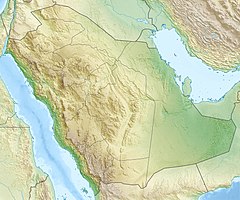Makkah Al Mukarramah Library
| House of the Birth[1][2] Makkah Al Mukarramah Library | |
|---|---|
 The library which stands on the spot where Muhammad is believed to have been born | |
| Religion | |
| Affiliation | Islam |
| Region | Makkah Province, Hejaz |
| Rite | Ziyarat |
| Leadership | Al Saud |
| Location | |
| Location | Near Al-Masjid al-Haram, Mecca, Hejaz, |
| Municipality | Makkah |
| Administration | Al Saud |
| Geographic coordinates | 21°25′30″N 39°49′48″E / 21.42500°N 39.83000°E |
| Architecture | |
| Type | Library |
| Founder | Saudi King 'Abdul-'Aziz bin 'Abdul-Rahman Al Saud[1] |
Makkah Al Mukarramah Library (Arabic: مَكْتَبَة مَكَّة ٱلْمُكَرَّمَة, romanized: Maktabah Makkah Al-Mukarramah)[3][4] is a library near the Masjid al-Haram in Mecca, Saudi Arabia. Since it is believed to stand on the spot where the Islamic prophet Muhammad was born, it is also known as Bayt al-Mawlid (Arabic: بَيْت ٱلْمَوْلِد, lit. 'House of the Birth').[1][2]
History[edit]

Ancient[edit]
Aminah bint Wahb ibn Abd Manaf is believed to have given birth to Muhammad[5] in the month of Rabi' al-Awwal,[6] circa 53 B.H. or 570 C.E.[7][8][9] Her husband, Abdullah ibn Abd al-Muttalib, had died three[10] to six[11] months prior.[12]
Modern[edit]
After consulting senior scholars, 'Abdul-'Aziz bin 'Abdul-Rahman Al Saud, the founding king of modern Saudi Arabia, established the modern library over the site of Muhammad's birth.[1]
See also[edit]
- Church of the Nativity, birthplace of 'Isa (Jesus)
- Family tree of Muhammad
- The Green Dome over the tomb of Muhammad
References[edit]
- ^ a b c d e Ibrahim, Dr. Abdul-Wahhab Abu Sulaiman (2012-04-07). "Establishing The Location of the Bayt al-Mawlid". Dar al-Hadith. Retrieved 2022-07-18.
- ^ a b c "Bayt al-Mawlid". Hajj & Umrah Planner. Makkah. Retrieved 2022-07-18.
- ^ a b Hīlah, Muḥammad Al-Ḥabīb (1994-03-01). Fahras Makhṭūṭāt Maktabat Makkah al-Mukarramah [Handlist of Manuscripts in the Library of Makkah Al-Mukarramah] (in Arabic) (1 ed.). Mecca, Saudi Arabia: Muʾassasat al-Furqān lil-Turāth al-Islāmī (Al-Furqan Islamic Heritage Foundation). ISBN 978-1-8739-9210-4.
- ^ a b Hīlah, Muḥammad Al-Ḥabīb (1994-12-31). Fahras Makhṭūṭāt Maktabat Makkah al-Mukarramah [Handlist of Manuscripts in the Library of Makkah Al-Mukarramah] (in Arabic) (2 ed.). Mecca, Saudi Arabia: Muʾassasat al-Furqān lil-Turāth al-Islāmī (Al-Furqan Islamic Heritage Foundation), Markaz Dirasat Maqasid Al-Shariah Al-Islamiyah. ISBN 978-1-8739-9209-8.
- ^ Al-A'zami, Muhammad Mustafa (2003). The History of The Qur'anic Text: From Revelation to Compilation: A Comparative Study with the Old and New Testaments. UK Islamic Academy. pp. 22–24. ISBN 978-1-8725-3165-6.
- ^ Anis Ahmad (2009). "Dīn". In Esposito, John L. (ed.). The Oxford Encyclopedia of the Islamic World. Oxford, England, the U.K.: Oxford University Press. Archived from the original on 5 December 2017.
A second important aspect of the meaning of the term emerges in Meccan revelations concerning the practice of the Prophet Abraham. Here it stands for the straight path (al-dīn al-ḥanīf) toward which Abraham and other messengers called the people [...] The Qurʿān asserts that this was the path or practice followed by Abraham [...] In the final analysis, dīn encompasses social and spiritual, as well the legal and political behaviour of the believers as a comprehensive way of life, a connotation wider than the word "religion."
- ^ Conrad, Lawrence I. (1987). "Abraha and Muhammad: some observations apropos of chronology and literary topoi in the early Arabic historical tradition1". Bulletin of the School of Oriental and African Studies. 50 (2): 225–40. doi:10.1017/S0041977X00049016. S2CID 162350288.
- ^ Sherrard Beaumont Burnaby (1901). Elements of the Jewish and Muhammadan calendars: with rules and tables and explanatory notes on the Julian and Gregorian calendars. G. Bell. p. 465.
- ^ Hamidullah, Muhammad (February 1969). "The Nasi', the Hijrah Calendar and the Need of Preparing a New Concordance for the Hijrah and Gregorian Eras: Why the Existing Western Concordances are Not to be Relied Upon" (PDF). The Islamic Review & Arab Affairs: 6–12. Archived from the original (PDF) on 5 November 2012.
- ^ "Muhammad: Prophet of Islam". Encyclopædia Britannica. 28 September 2009. Retrieved 28 September 2009.
- ^ Meri, Josef W. (2004). Medieval Islamic civilization. Vol. 1. Routledge. p. 525. ISBN 978-0-415-96690-0. Archived from the original on 14 November 2012. Retrieved 3 January 2013.
- ^ "Early Years". Al-Islam.org. 18 October 2012. Retrieved 18 October 2018.
External links[edit]



